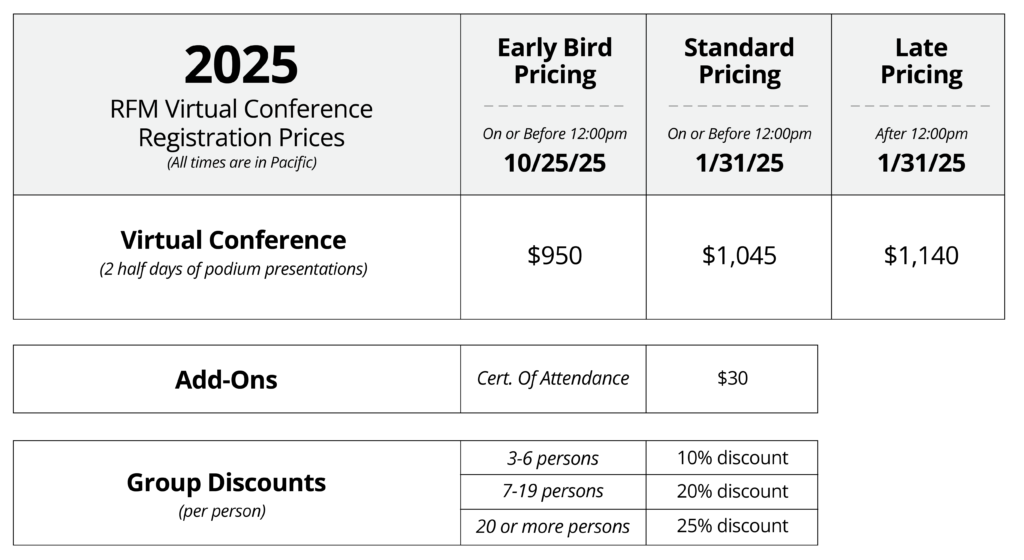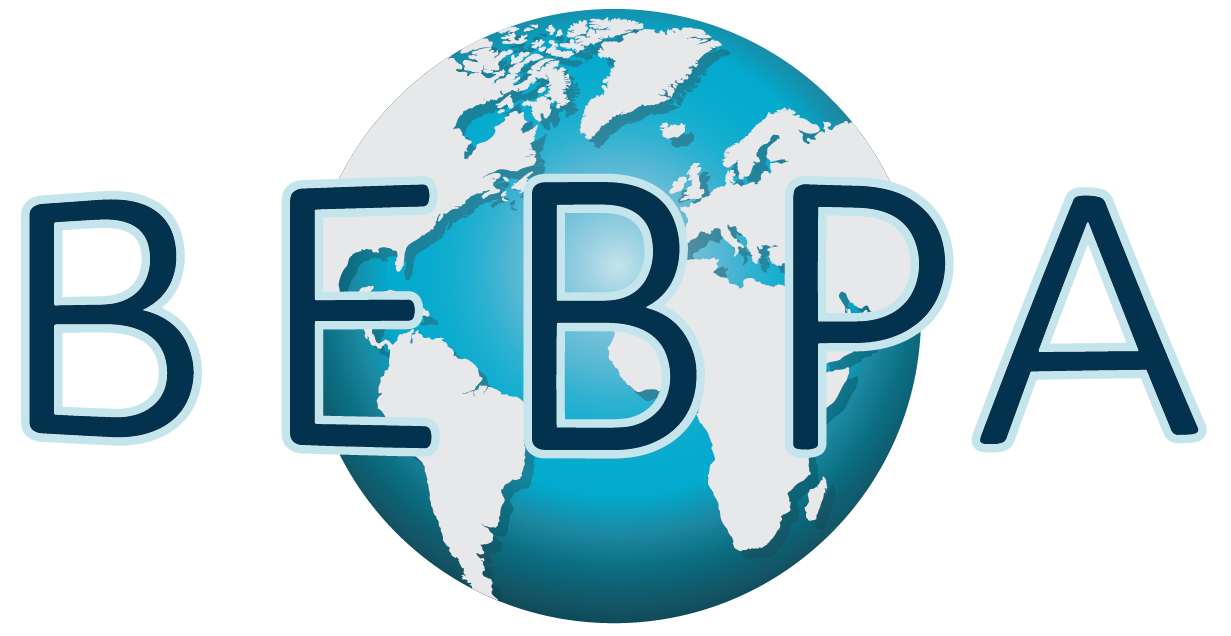2025 Reference Material Conference
Virtual | February 25-26, 2025
Registration
Registration is open for our Virtual 2025 Reference Material Conference. Registration closes February 21th.

Agenda
Our Draft 2025 Virtual Reference Material Conference agenda is coming soon! Check the agenda for updates as we finalize our schedule.
2025 RFM Speaker Abstracts
Kevin Brooks, K.R. Brooks Associates LLC
Title: Statistical Process Control – EWMA, CUSUM and Then Some
Abstract: The primary goal of Statistical Process Control (SPC) is to achieve process stability and enhance process capability by minimizing variability. This is achieved by quickly detecting assignable causes of variation, allowing for timely investigations and effective problem resolution.
To identify small to moderate shifts—often referred to as outliers or anomalies—in process parameters such as location and dispersion, the classical cumulative sum (CUSUM) and exponentially weighted moving average (EWMA) control charts are frequently utilized. However, these methods may struggle to detect out-of-control signals associated with shifts of ±1.0 standard deviation. This limitation can lead to costly delays in identifying and addressing problematic shifts.
Poor process quality may result in excessive scrapping of entire lots, leading to unnecessary costs and time spent on reworking subpar products. We will compare the performance measures of CUSUM and EWMA control charts against our proposed method to better address and mitigate these issues.
Siân Estdale, BEBPA
Title: Industry Insights Into the Practices Related to In-House Reference Materials and Use of International Reference Standards for Potency Assays
Abstract: TBA
Seth Foltz, Eli Lilly and Company
Title: Business Case for a Central Corporate Reference Standard Organization
Abstract: Complex biopharmaceutical products present a significant challenge during each stage of drug development, including for reference standard management. Complexity also varies by product type such as for monoclonal antibodies, peptides, siRNA, gene therapy, and small molecules. All these factors, and more, drive the need to establish the optimal approach for reference standard management at your company. This presentation explores various options, including a focus on evaluating if a centralized corporate reference standard organization is the best practice for managing reference standards at a mid to large pharmaceutical company.
John Hogwood, Medicines and Healthcare products Regulatory Agency
Title: Considerations When Establishing a Biological Material as an International Standard
Abstract: The World Health Organization (WHO) through its Expert Committee on Biological Standards (ECBS) has been responsible for establishing a broad range of different biological reference materials as International Standards (ISs). These materials are produced to ensure harmonization of biological therapeutics and diagnostic monitoring where a bioassay method is considered the only means of potency/activity assurance. On behalf of the WHO, the UK’s Medicines Healthcare products Regulator Agency (MHRA) has responsibility (following integration of NIBSC) of maintaining/establishing a range of these ISs. The establishment of any IS typically involves investigations into a suitable candidate reference prior to an international multicenter study which value assigns the chosen candidate. Invariably each IS produced has different concerns that can contribute to their suitability, which includes the ‘nature’ of the biological, the stability of the material and the type(s) of bioassay used. Several examples within the field of hemostasis will be given which highlight the complexities associated with establishing a WHO IS.
Laureen Little, BEBPA
Title: Industry Insights Into the Practices Related to In-House Reference Materials and Use of International Reference Standards for Potency Assays
Abstract: TBA
Jane Robinson, BEBPA
Title: 2024 White Paper on Reference
Standards for Potency Assays
Abstract:
In 2024, BEBPA published a white paper, Reference Standards for Potency Assays. This paper resulted from extensive discussions between experts from biopharmaceutical manufacturers, regulatory agencies, CROs and consultants, including statisticians, and presents an overview of current practices common in the biopharmaceutical industry for the development of in-house reference standards for use in bioassays to determine the potency of biopharmaceutical preparations. The general principles behind the development and use of in-house reference standards and the different requirements for the reference standard at different stages of product development will be reviewed, highlighting some of the more problematic issues commonly encountered.
Raffaella Rossi, Bavarian Nordic
Title: Industry Insights Into the Practices Related to In-House Reference Materials and Use of International Reference Standards for Potency Assays
Abstract: TBA
Nancy Sajjadi, Sajjadi Consulting
Title:Reference Qualification for Relative Potency Assays: You Can’t Prove Not Different Only Not Too Different
Abstract: It is common practice to use statistical equivalence hypothesis testing to justify assignment of 100% relative potency when qualifying a new lot of reference material. This is accomplished by predefining the maximum amount the mean measured value of the replacement can drift from the original 100% value assigned to the primary reference. Although an underestimate or overestimate of the true value of the new reference lot can introduce bias into test results when compared to measurements made against the primary, the equivalence bounds establish limits and corresponding lot release specifications can budget for such impact. Because statistical equivalence can only be concluded when the mean measured value and its entire confidence interval (typically 90%) fit within the established bounds, greater statistical power allows for the measured value of a new reference to get closer to the bounds. Smaller confidence intervals reflect low assay variability and/or high replication. However, some organizations also require the confidence interval to include the 100% target value so that the new reference result is simultaneously considered equivalent to, and not different from, the primary. Note that this additional latter requirement demands a greater measurement uncertainty (i.e. lower statistical power) as the true value of the new lot moves towards the equivalence bounds. This presentation will highlight a common misunderstanding of statistical difference testing that underpins this counterintuitive conundrum.
Jaana Vesterinen, Finnish Medicines Agency Fimea
Title: Regulatory Insights into the Practices Related to In-House Reference Materials and Use of International Reference Standards for Potency Assays
Abstract: To Be Announced
Byron Wingerd, K.R. Brooks Associates LLC
Title: Case Study: Reference Standard Stability Effects in a Relative Potency Assay
Abstract: The stability of a reference material over its use lifecycle is of particular importance for any standard material especially those use for determining the relative potency of new material lots. Often consistency within a reference lot is assumed providing unintended and cryptic consequences to the stability of the measurement system.
In this case study we will review observations from a representative case study where multiple modes of unintended variation surreptitiously conspired to produce apparent shifts in the potency of a biopharmaceutical product. Only by carefully defining and assembling the correct data sources were the sources of variation peeled back to revel the culprit behind the product’s potency variation.
Quick Links
February 25-26, 2025
Virtual Conference
